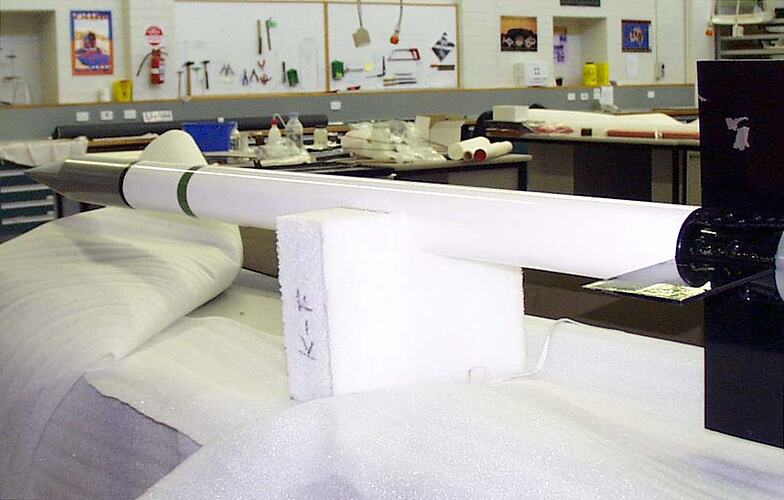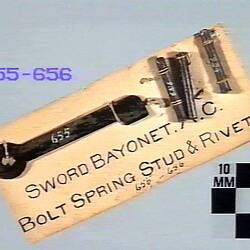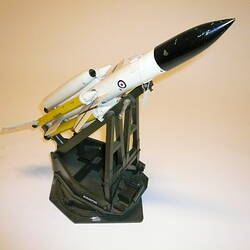Summary
Alternative Name(s): Sounding Rocket
Kookaburra Mark 1, Australian-designed, upper atmosphere research rocket powered by a two-stage (Lupus 1A & Musca) cast composite propellant motor. First launched in 1968, it was used to deploy a parachute-equipped drop sonde which measured upper atmospheric air temperatures and pressures as well as ozone and molecular oxygen concentrations. It could reach a maximum altitude (apogee) of about 75 kilometres, with a typical launch elevation of 82.5° and remained in use until 1975, with an average of 11 firings a year. In March 1970, Australia took part in a joint launch program with the United Kingdom and India to provide a comparative assessment of atmospheric temperature and ozone levels in the Indian Ocean region using group firings of Kookaburra rockets. The rocket motors were manufactured by the Maribyrnong Explosives Factory in Melbourne and the rocket was developed and tested by the Weapons Research Establishment (WRE) at Woomera in South Australia. Mark 2 and Mark 3 versions were developed before 1975 when the Australian research rocket program was terminated.
This example of a Kookaburra Mk. 1 is believed to have been manufactured in 1975 and remained unused at the end of the research program. It was donated to the Museum by the Department of Defence, Maribrynong Explosives Factory in 1994.
Physical Description
Overall rocket consists of two slender pencil or needle-like stages with straight-sided cylindrical bodies 126 mm diameter in the lower or first stage and 89 mm diameter in the upper or second stage. Each stage has four rectangular plan form stabilising fins attached to the nozzle at the base in a cruciform arrangement. All fins are of a plain rectangular shape with uniform thickness throughout. The body of each stage is painted cream/white, with black stenciled lettering, black fins and nozzle and a 7.5° tapered polished metal alloy nose. The lower stage is also fitted with a tapered polished metal tip which fits inside the conical nozzle of the upper stage.
More Information
-
Collecting Areas
-
Acquisition Information
Donation from Australia: Defence Department, Maribyrnong Explosives Factory, by Oct 1994
-
Manufacturer
Australia: Defence Department, Maribyrnong Explosives Factory, Maribyrnong, Greater Melbourne, Victoria, Australia, 1975
Manufactrured at the Maribyrnong Explosives Factory, Victoria. Rocket motors static tested at their Ravenhall facility in Deer Park, range tested at the Weapons Research Establishment's Woomera Firing Range, South Australia. -
Designer
Upper Atmosphere Research Group, Weapons Research Establishment (WRE), Upper Atmosphere Research Group, South Australia, Australia, 1968
-
Place & Date Tested
Australia: Defence Department, Ravenhall Explosives Testing Range, Ravenhall, Deer Park, Greater Melbourne, Victoria, Australia, circa 1969
-
Place & Date Tested
Woomera Rocket Range, Australia: Defence Department, Weapons Research Establishment (WRE), Woomera, South Australia, Australia, circa 1969
-
Model Name or Number
-
Classification
-
Category
-
Discipline
-
Type of item
-
Overall Dimensions
3535 mm (Length), 425 mm (Width), 130 mm (Outside Diameter), 27.5 kg (Weight)
Overall dimensions when the two stages are assembled into a full rocket. Individual lengths of each part overlap by 125 mm when assembled. Previously Overall Length was given as 3350 mm which seems to be incorrect. Weight given is combined weight of both sections as measured by Moreland staff, 15/1/2009.
-
Other Dimensions
43.5 kg (Weight)
Overall Weight with Propellant Loaded
-
Dimensions
353 cm (Length), 33 cm (Outside Diameter)
Measurement From Conservation. Measuring Method: maximum dimensions
-
Dimensions
1870 mm (Length), 210 mm (Height), 305 mm (Outside Diameter)
Measurement From Conservation.
-
References
Morton, Peter, 'Fire Across the Desert', pp.402-405.
[Other] Brown, D. P. & Burger, F. G. 1974. Study of a Family of Sounding Rockets Formed by the Combination of Various Existing and Hypothetical Rocket Motors., Note-1174, March 1974
-
Keywords



